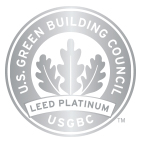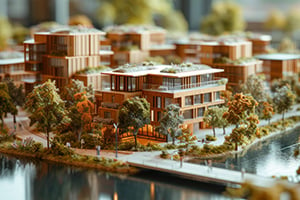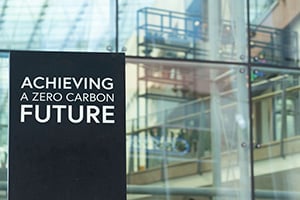By Tim Peterson
Sustainability Analyst Intern, Sustainable Investment Group (SIG)
 Sustainable Investment Group’s (SIG) headquarters is no typical office space. There are no cubicles or partitions; just an open-office space that breathes in the outdoors through floor to ceiling windows. They stretch the full length of the office’s southern wall, bathing the room in natural light. A large fir tree peers in the window, its bright green needles shimmering in the Georgia sun. This is SIG HQ, and it has been designed to embody everything about sustainability.
Sustainable Investment Group’s (SIG) headquarters is no typical office space. There are no cubicles or partitions; just an open-office space that breathes in the outdoors through floor to ceiling windows. They stretch the full length of the office’s southern wall, bathing the room in natural light. A large fir tree peers in the window, its bright green needles shimmering in the Georgia sun. This is SIG HQ, and it has been designed to embody everything about sustainability.
When it comes to being LEED consultants and educators, SIG has always defined itself through an office culture devoted to sustainability and the natural environment. This year, SIG has begun the process of making it official: getting a LEED certification for its Atlanta office. While the SIG headquarters already exists in a LEED Gold and ENERGY STAR certified building, the new office is currently in the process of achieving Platinum certification through the LEED for Interior Design and Construction rating system.
 The road to achieving LEED Platinum is never an easy task, but SIG’s decision to lease office space in a LEED Gold building has its advantages. These advantages take many forms: proximity to the Medical Center MARTA station promotes transit commuting, the 1st floor cafeteria and a food court across the street increases walkability, a full fitness center promotes tenant wellbeing, and bike racks and showers on site incentivize office workers to combine their morning commute and work-out.
The road to achieving LEED Platinum is never an easy task, but SIG’s decision to lease office space in a LEED Gold building has its advantages. These advantages take many forms: proximity to the Medical Center MARTA station promotes transit commuting, the 1st floor cafeteria and a food court across the street increases walkability, a full fitness center promotes tenant wellbeing, and bike racks and showers on site incentivize office workers to combine their morning commute and work-out.

During the construction of the new office space, SIG took big steps to ensure a high diversion rate of any construction waste, and ensure the safety of all construction workers and employees. SIG did this through the implementation of air scrubbers equipped with MERV 8 air filters on the construction site, which reduced the amount of particulate matter in the air. Particulate matter (PM) is a complex mixture of extremely small particles and liquid droplets, including acids, organic chemicals, metals, and soil or dust particles, all of which can cause serious health issues when inhaled. Along with these filters, SIG also utilized zero VOC and low VOC paints, sealants, and adhesives. VOCs (volatile organic compounds) are similar to particulate matter from a human health standpoint: inhaling these chemicals can cause a plethora of health complications. Some high VOC products such as paints emit VOCs long after they have dried, making a space potentially hazardous to occupant’s health long after construction is completed. This was an easy decision for SIG, since low VOC and zero VOC products are no more expensive than their harmful counterparts.
SIG also decided to only use wood certified by the Forestry Stewardship Council (FSC). The FSC ensures that all the wood products they certify come from responsibly managed forests, which office designers took into account when sourcing wood for the new breakroom cabinets.
In the actual design of the office space, the certification team made sure to reuse as much as possible from their previous office. One example of reuse was the decision to keep all of the chairs and desks from their previous office space, and supplement these existing durable goods with GreenGuard certified chairs.
Another decision was to purchase renewable energy certificates (RECs) from Renewable Choice Energy. The cost of these RECs are based on the estimated energy usage of the office space over two years, which is then sent to Renewable Choice Energy to subsidize the research, development, and production of a renewable energy source across the United States.

Along with the purchase these RECs, SIG purchased only ENERGY STAR certified appliances and supplemented its single stream recycling with composting, diverted and handled through the local service-provider Compost Wheels. Compost Wheels offers a pick-up service that takes all of SIG’s breakroom organic waste and composts it. This service operates a closed loop system for compost pick-up, achieving minimal amounts of emissions from fossil fuels by keeping the generated compost local by supplying it to different applications in the surrounding neighborhood.
These examples make up only a fraction of SIG’s office innovations. While all of these investments make the SIG headquarters sustainable, it is the culture and mentality that these design elements create that define SIG: people striving to inspire those around them in the constantly evolving quest for sustainability in the built environment.
© 2015 Sustainable Investment Group (SIG). All Rights Reserved.



